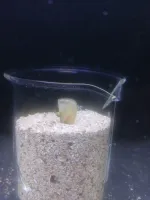This past weekend, July 12-13, was significant for our Wildlife Rescue Centre. Each day, a young juvenile loggerhead sea turtle arrived in critical condition. Upon arrival, the turtles were immediately admitted for emergency veterinary care, where they received fluids and glucose, and we began removing the thick layer of goose barnacles from their shells. Further treatment will be determined based on the results of X-rays and blood tests.
Goose barnacles are small crustaceans that attach themselves to hard surfaces in the sea, such as rocks, boats, and marine animals. Although their presence on turtles might seem harmless, it often indicates serious health issues. A healthy sea turtle is constantly on the move—swimming, diving, surfacing, and travelling long distances—which prevents barnacles from settling on its body for too long. When a turtle is covered in barnacles, it usually means the animal is weakened, injured, or ill, that it has spent too much time on the seafloor, or is no longer able to swim properly.
In such a state, its carapace becomes a suitable surface not only for barnacles but also for algae, molluscs, and other organisms. Large accumulations of these parasites further hinder movement, increase water resistance, and can cause irritation or even damage to the skin and shell. They especially tend to gather around wounds, where the tissue is already weakened. The condition in which these turtles were found is known as Debilitated Turtle Syndrome. This is a serious health disorder caused by a combination of factors, including bacterial infections, pollutant poisoning, injuries, and parasites that interfere with normal feeding, breathing, and swimming.
The turtle Frida was found by a Slovenian family in the shallow waters of Centinera Bay in Banjole. She weighs around 300 grams, her shell is 14 cm long, and she is less than a year old. The second turtle, Havajka, was found near the beach of the same name in Verudela: she was brought to the shore by a group of tourists and reported to us by the lifeguard on duty. She weighs around 1 kg, has a shell length of 20 cm, and is estimated to be about a year old.
We thank everyone who participated in bringing the turtles to the Rehabilitation Center, as well as our volunteers and veterinarians Paula, Johanne, and Lucie, who began cleaning their carapaces.































